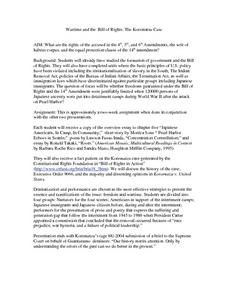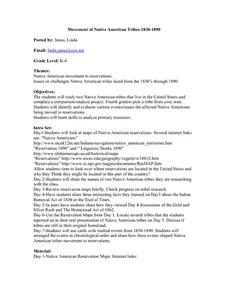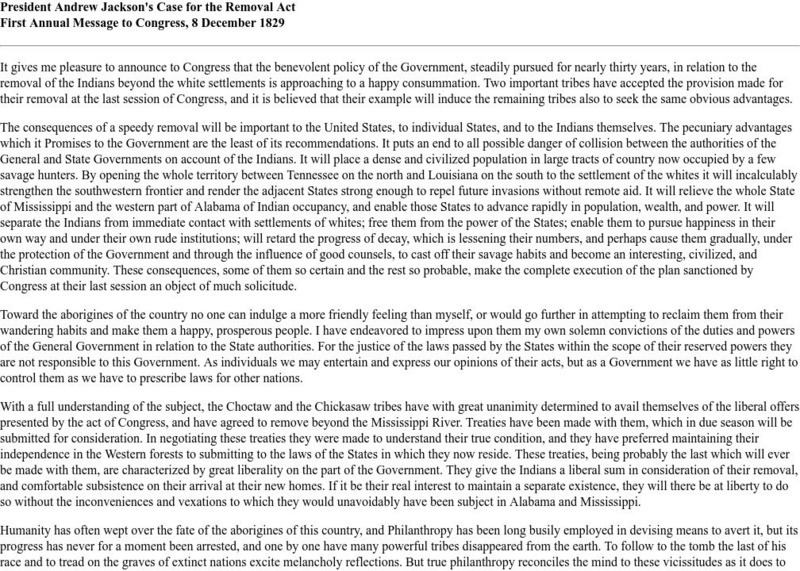Curated OER
Trail of Tears
A fabulous PowerPoint resource that thoroughly and accurately desicribes the Cherokee culture from the 1500's through the mid-1800's when they were forced to leave their homeland and march to Oklahoma in the famous, "Trail of Tears."...
Curated OER
Kill the Indian to Save the Man: Reservations, Assimilation, and Native American Resistance and Persistence in the West
Students investigate the theory versus the reality of US government reservation policy in the mid to late 19th Century by watching a video. They design a time line that shows how the individual tribes surrendered to the reservation...
Curated OER
The Trail of Tears
Students investigate the terms of the Indian Removal Act of 1830. They research the implications of the Indian Removal Act for Native American people. Students demonstrate an understand the impact of Manifest Destiny had on Native...
Curated OER
Third Grade Social Studies- Quiz
In this social studies learning exercise, students complete a 25 question multiple choice quiz about early American colonial life and the Cherokee and other Native American tribes.
Curated OER
Jim Thorpe's Bright Path
Young scholars read about the life of Jim Thorpe and answer focus lessons about the book. In this Jim Thorpe lesson, students celebrate the American Indian culture and learn of the hardships Jim Thorpe overcame. Young scholars find...
Curated OER
Stop Action and Assess Alternatives
Students stop action and determine how history may have been altered. In this historical perspectives lesson, students consider how the Cherokee Removal, the Transcontinental Railroad, the Immigration Act of 1924, and the dropping of the...
Curated OER
Andrew Jackson and the Trail of Tears
Students examine the three historical portraits Andrew Jackson, iam Pitt and Portrait of a Boy for symbolism. They research Andrew Jackson's involvement in the Cherokee Indians' Trail of Tears in North Carolina, and compose a portrait.
Curated OER
The Trail of Tears; Its Grief and Loss
Fifth graders are introduced to the removal of Native Americans along the Trail of Tears. In groups, they examine the political factors that caused this removal and its effect on society. To end the activity, they discuss various ways...
Curated OER
Wartime and the Bill of Rights: The Korematsu Case (Lesson 2)
Twelfth graders review how the government and Bill of Rights came into effect. Using primary source documents, they discuss if Japanese rights were violated when they were placed in internment camps after the bombing of Pearl Harbor. ...
Curated OER
Sunken Millions: The Way West
Recover sunken treasure with this interactive PowerPoint! Break your class into two teams: the divers and the surfers. They'll work together to answer 20 multiple choice questions, reviewing major events that occurred during the 1800s....
Curated OER
Movement of Native American Tribes 1830-1890
Students examine the movement of Native American tribes during the mid 1800's. In this American History lesson, students study two Native American tribes that live in the United States and complete a comparison/analyze project. Students...
Curated OER
Native Americans
Students choose two photographs and explain how they illustrate traditional Native American culture. They discuss how traditional Native American culture has been affected by two specific actions of the United States Government, (they...
Calvin Crest Outdoor School
Survival
Equip young campers with important survival knowledge with a set of engaging lessons. Teammates work together to complete three outdoor activities, which include building a shelter, starting a campfire, and finding directions in the...
Curated OER
Changing Opinions
Students compare their preconceptions of Native American movement with their current perceptions. They identify why they have changed. Students conclude with a final reflection addressing how they define the Native American experience in...
Curated OER
Does This Belong to You?
Fourth graders examine legislation that has been passed to protect the rights and religion of Native Americans. In groups, they discuss their feelings on others taking artifacts from Native American sites and what they do if they find...
OpenStax
Open Stax: Indian Removal
By reading this section of a chapter on "Jacksonian Democracy," students will be able to explain the legal wrangling that surrounded the Indian Removal Act and describe how depictions of Indians in popular culture helped lead to Indian...
US National Archives
Our Documents:president Jackson's Message to Congress 'On Indian Removal' (1830)
On December 6, 1830, President Jackson spoke to Congress about his position on relocating Indians in order to make way for settlers in the west. This paved the way for government policy in dealing with native peoples even after his...
Smithsonian Institution
Smithsonian: National Museum of the American Indian: The Removal Act
At first, the Trail of Tears only described the Cherokee removal of 1838. Later it included the removals of all southeastern Native nations. Take a close look at these primary sources from the Smithsonian which include a reproduction of...
US National Archives
Our Documents: President Andrew Jackson's Message, 'On Indian Removal'
Interactive image of the original document through which President Andrew Jackson called for "Indian Removal," in 1830. Includes transcription as well as background and overview of the text and results of the Indian Removal policy.
Digital History
Digital History: Indian Removal
The Indian Removal policy was inhumane and without empathy for the Native Americans who were forced from their lands. Read about the attempts to enforce federal treaties and the final removal of three major tribes from the Southeast.
Missouri State University
Delaware Town: Removal Era
Discussion of the removal of American Indians living east of the Mississippi River beginning in the late 1700s. Initially, these removals were voluntary, resulting from treaty negotiations. In 1830, Congress passed the Indian Removal...
Mount Holyoke College
International Relations: Andrew Jackson's Case for the Removal of Indians
Here, read the text to President Jackson's "First Annual Message to Congress, 8 December 1830," in which Jackson argues for the removal of Native Americans.
PBS
Pbs Learning Media: Cherokee Nation: Virtual Field Trip
An in-depth look at the lives of the Cherokee Indians, from their first encounters with Europeans to events, such as the Gold Rush and the signing of the Indian Removal Act by Andrew Jackson, that led to their forced relocation to Indian...
Ohio State University
Osu History Teaching Institute: Indian Removal
This lesson looks at the process whereby a policy of assimilation gave way to one of overt removal under President Jackson.
Other popular searches
- Indian Removal Act Cartoon
- Indian Removal Act Map
- Indian Removal Act 1830
- Indian Removal Act Trails
- Indian Removal Act Today
- Indian Removal Act Raft
- American Indian Removal Act
- Indian Removal Act of 1830






















